King Edward VII College: Operational Plan, Resource Management Project
VerifiedAdded on 2023/01/12
|22
|5658
|94
Project
AI Summary
This project proposal outlines an operational plan for King Edward VII College, focusing on its expansion with new campuses in Sydney and Brisbane. The project is divided into four main assessments. The first assessment addresses the purpose of strategic and operational plans, the information included in an operational plan, the process for developing one, the purpose of a budget and budgeting process, the purpose of key performance indicators (KPIs) and approaches to developing them, the balanced scorecard, benchmarking, PCBU responsibilities, and the Fair Work Act. The second assessment involves developing an operational plan, a risk management plan, and related communications. The third assessment focuses on managing resource acquisition, including strategies for recruiting staff and purchasing equipment. The final assessment covers operational planning, monitoring, and review. The document includes various emails to senior management, the CEO, and the HR and administration teams, demonstrating the practical application of operational planning principles.
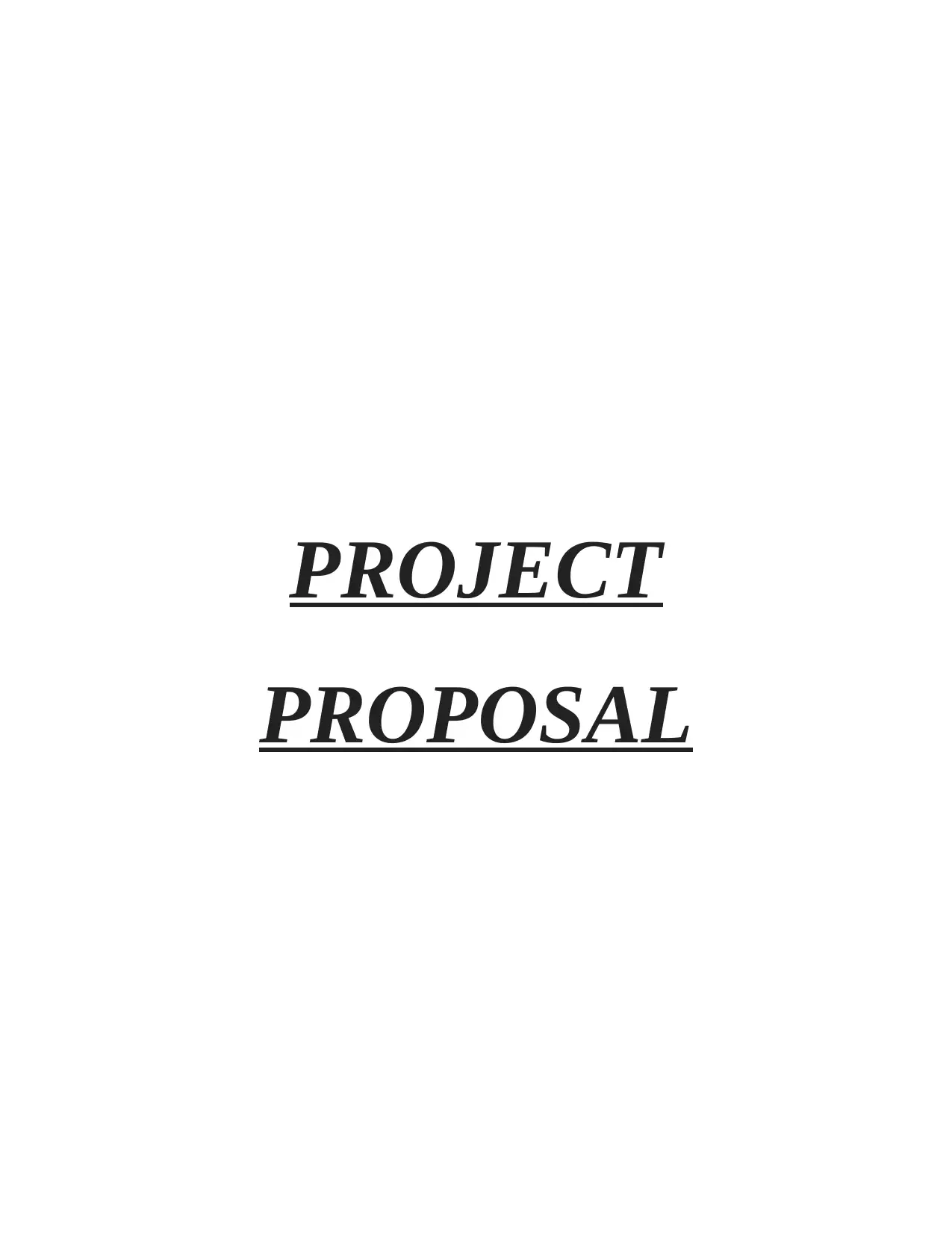
PROJECT
PROPOSAL
PROPOSAL
Paraphrase This Document
Need a fresh take? Get an instant paraphrase of this document with our AI Paraphraser
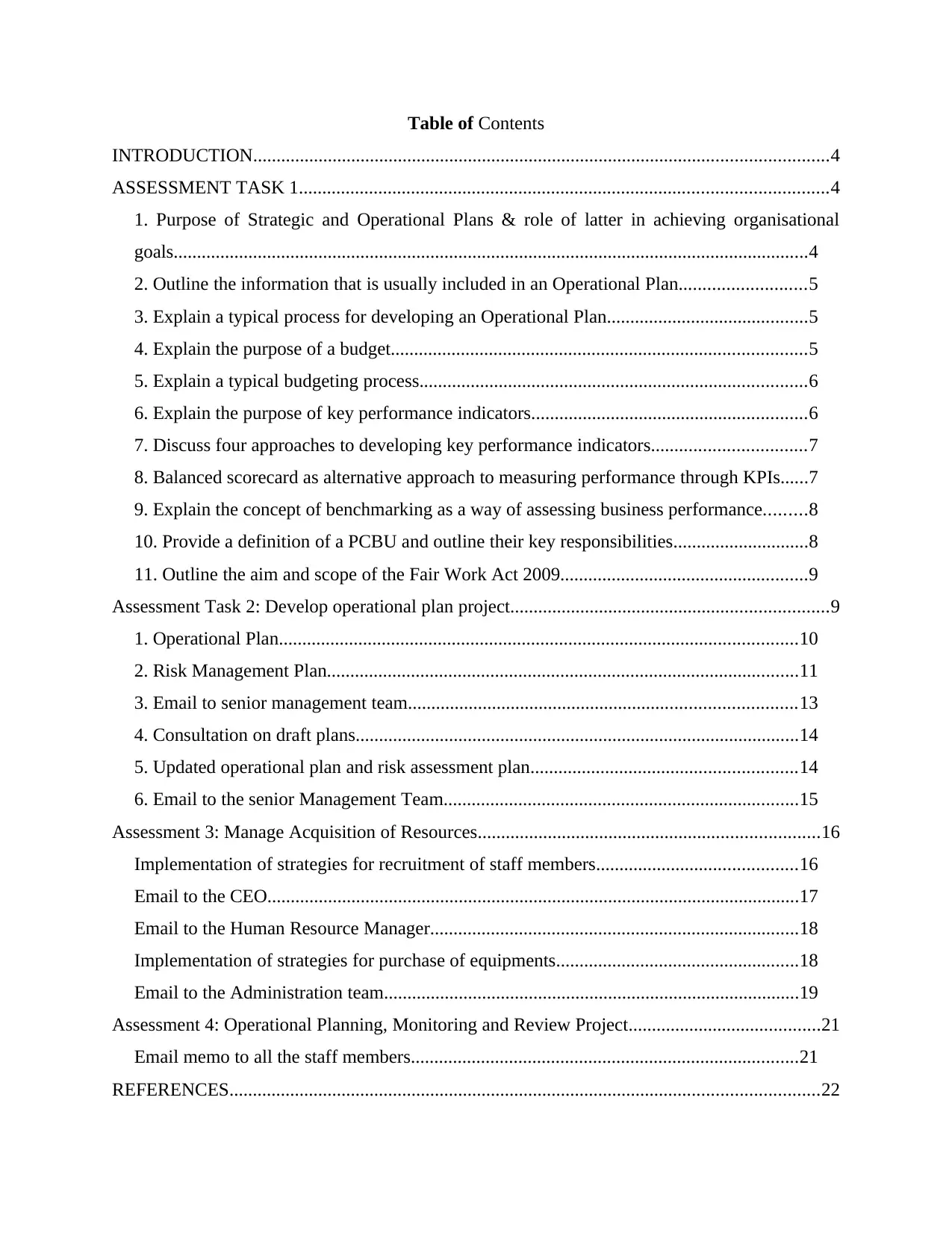
Table of Contents
INTRODUCTION...........................................................................................................................4
ASSESSMENT TASK 1.................................................................................................................4
1. Purpose of Strategic and Operational Plans & role of latter in achieving organisational
goals........................................................................................................................................4
2. Outline the information that is usually included in an Operational Plan...........................5
3. Explain a typical process for developing an Operational Plan...........................................5
4. Explain the purpose of a budget.........................................................................................5
5. Explain a typical budgeting process...................................................................................6
6. Explain the purpose of key performance indicators...........................................................6
7. Discuss four approaches to developing key performance indicators.................................7
8. Balanced scorecard as alternative approach to measuring performance through KPIs......7
9. Explain the concept of benchmarking as a way of assessing business performance.........8
10. Provide a definition of a PCBU and outline their key responsibilities.............................8
11. Outline the aim and scope of the Fair Work Act 2009.....................................................9
Assessment Task 2: Develop operational plan project....................................................................9
1. Operational Plan...............................................................................................................10
2. Risk Management Plan.....................................................................................................11
3. Email to senior management team...................................................................................13
4. Consultation on draft plans...............................................................................................14
5. Updated operational plan and risk assessment plan.........................................................14
6. Email to the senior Management Team............................................................................15
Assessment 3: Manage Acquisition of Resources.........................................................................16
Implementation of strategies for recruitment of staff members...........................................16
Email to the CEO..................................................................................................................17
Email to the Human Resource Manager...............................................................................18
Implementation of strategies for purchase of equipments....................................................18
Email to the Administration team.........................................................................................19
Assessment 4: Operational Planning, Monitoring and Review Project.........................................21
Email memo to all the staff members...................................................................................21
REFERENCES..............................................................................................................................22
INTRODUCTION...........................................................................................................................4
ASSESSMENT TASK 1.................................................................................................................4
1. Purpose of Strategic and Operational Plans & role of latter in achieving organisational
goals........................................................................................................................................4
2. Outline the information that is usually included in an Operational Plan...........................5
3. Explain a typical process for developing an Operational Plan...........................................5
4. Explain the purpose of a budget.........................................................................................5
5. Explain a typical budgeting process...................................................................................6
6. Explain the purpose of key performance indicators...........................................................6
7. Discuss four approaches to developing key performance indicators.................................7
8. Balanced scorecard as alternative approach to measuring performance through KPIs......7
9. Explain the concept of benchmarking as a way of assessing business performance.........8
10. Provide a definition of a PCBU and outline their key responsibilities.............................8
11. Outline the aim and scope of the Fair Work Act 2009.....................................................9
Assessment Task 2: Develop operational plan project....................................................................9
1. Operational Plan...............................................................................................................10
2. Risk Management Plan.....................................................................................................11
3. Email to senior management team...................................................................................13
4. Consultation on draft plans...............................................................................................14
5. Updated operational plan and risk assessment plan.........................................................14
6. Email to the senior Management Team............................................................................15
Assessment 3: Manage Acquisition of Resources.........................................................................16
Implementation of strategies for recruitment of staff members...........................................16
Email to the CEO..................................................................................................................17
Email to the Human Resource Manager...............................................................................18
Implementation of strategies for purchase of equipments....................................................18
Email to the Administration team.........................................................................................19
Assessment 4: Operational Planning, Monitoring and Review Project.........................................21
Email memo to all the staff members...................................................................................21
REFERENCES..............................................................................................................................22

⊘ This is a preview!⊘
Do you want full access?
Subscribe today to unlock all pages.

Trusted by 1+ million students worldwide
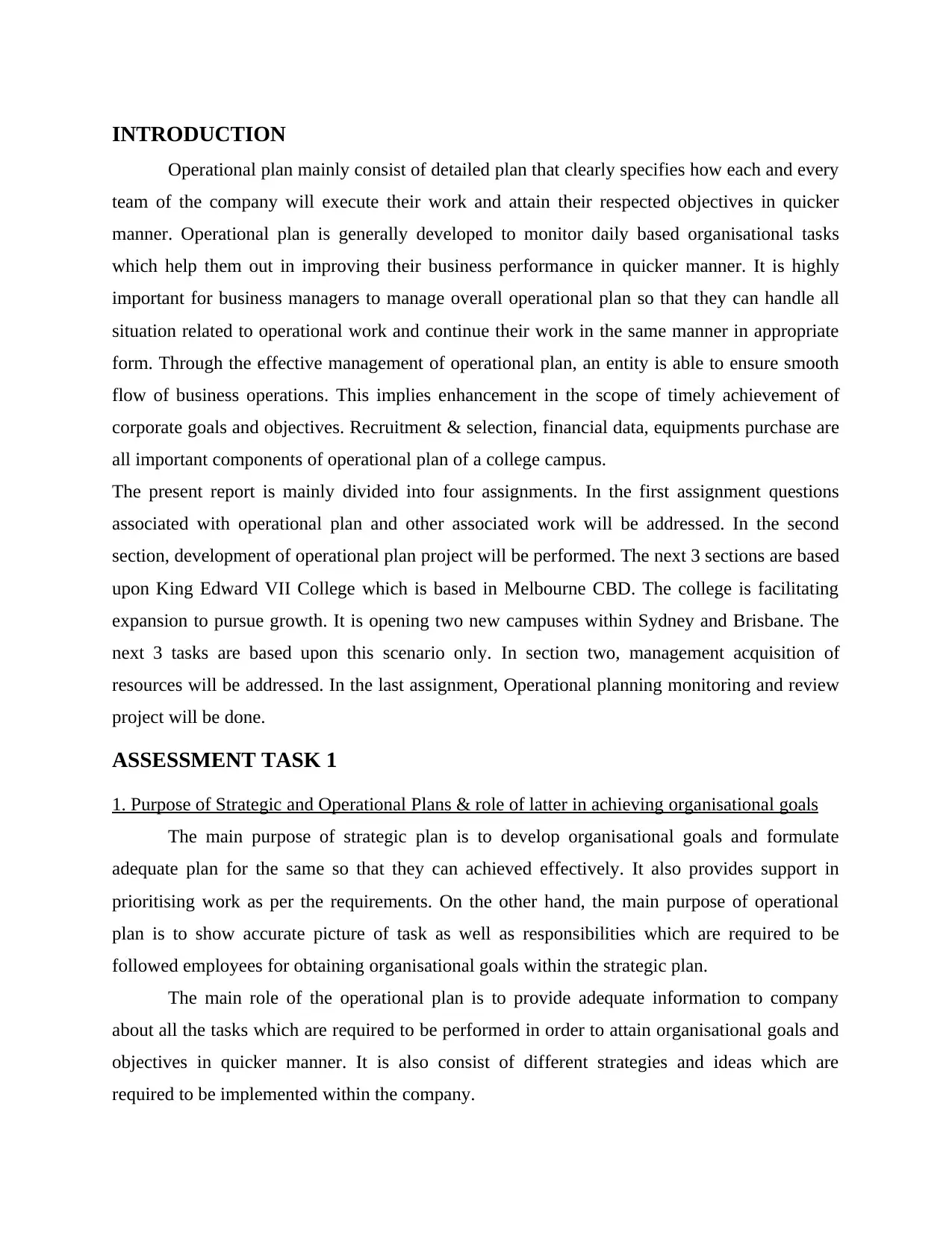
INTRODUCTION
Operational plan mainly consist of detailed plan that clearly specifies how each and every
team of the company will execute their work and attain their respected objectives in quicker
manner. Operational plan is generally developed to monitor daily based organisational tasks
which help them out in improving their business performance in quicker manner. It is highly
important for business managers to manage overall operational plan so that they can handle all
situation related to operational work and continue their work in the same manner in appropriate
form. Through the effective management of operational plan, an entity is able to ensure smooth
flow of business operations. This implies enhancement in the scope of timely achievement of
corporate goals and objectives. Recruitment & selection, financial data, equipments purchase are
all important components of operational plan of a college campus.
The present report is mainly divided into four assignments. In the first assignment questions
associated with operational plan and other associated work will be addressed. In the second
section, development of operational plan project will be performed. The next 3 sections are based
upon King Edward VII College which is based in Melbourne CBD. The college is facilitating
expansion to pursue growth. It is opening two new campuses within Sydney and Brisbane. The
next 3 tasks are based upon this scenario only. In section two, management acquisition of
resources will be addressed. In the last assignment, Operational planning monitoring and review
project will be done.
ASSESSMENT TASK 1
1. Purpose of Strategic and Operational Plans & role of latter in achieving organisational goals
The main purpose of strategic plan is to develop organisational goals and formulate
adequate plan for the same so that they can achieved effectively. It also provides support in
prioritising work as per the requirements. On the other hand, the main purpose of operational
plan is to show accurate picture of task as well as responsibilities which are required to be
followed employees for obtaining organisational goals within the strategic plan.
The main role of the operational plan is to provide adequate information to company
about all the tasks which are required to be performed in order to attain organisational goals and
objectives in quicker manner. It is also consist of different strategies and ideas which are
required to be implemented within the company.
Operational plan mainly consist of detailed plan that clearly specifies how each and every
team of the company will execute their work and attain their respected objectives in quicker
manner. Operational plan is generally developed to monitor daily based organisational tasks
which help them out in improving their business performance in quicker manner. It is highly
important for business managers to manage overall operational plan so that they can handle all
situation related to operational work and continue their work in the same manner in appropriate
form. Through the effective management of operational plan, an entity is able to ensure smooth
flow of business operations. This implies enhancement in the scope of timely achievement of
corporate goals and objectives. Recruitment & selection, financial data, equipments purchase are
all important components of operational plan of a college campus.
The present report is mainly divided into four assignments. In the first assignment questions
associated with operational plan and other associated work will be addressed. In the second
section, development of operational plan project will be performed. The next 3 sections are based
upon King Edward VII College which is based in Melbourne CBD. The college is facilitating
expansion to pursue growth. It is opening two new campuses within Sydney and Brisbane. The
next 3 tasks are based upon this scenario only. In section two, management acquisition of
resources will be addressed. In the last assignment, Operational planning monitoring and review
project will be done.
ASSESSMENT TASK 1
1. Purpose of Strategic and Operational Plans & role of latter in achieving organisational goals
The main purpose of strategic plan is to develop organisational goals and formulate
adequate plan for the same so that they can achieved effectively. It also provides support in
prioritising work as per the requirements. On the other hand, the main purpose of operational
plan is to show accurate picture of task as well as responsibilities which are required to be
followed employees for obtaining organisational goals within the strategic plan.
The main role of the operational plan is to provide adequate information to company
about all the tasks which are required to be performed in order to attain organisational goals and
objectives in quicker manner. It is also consist of different strategies and ideas which are
required to be implemented within the company.
Paraphrase This Document
Need a fresh take? Get an instant paraphrase of this document with our AI Paraphraser
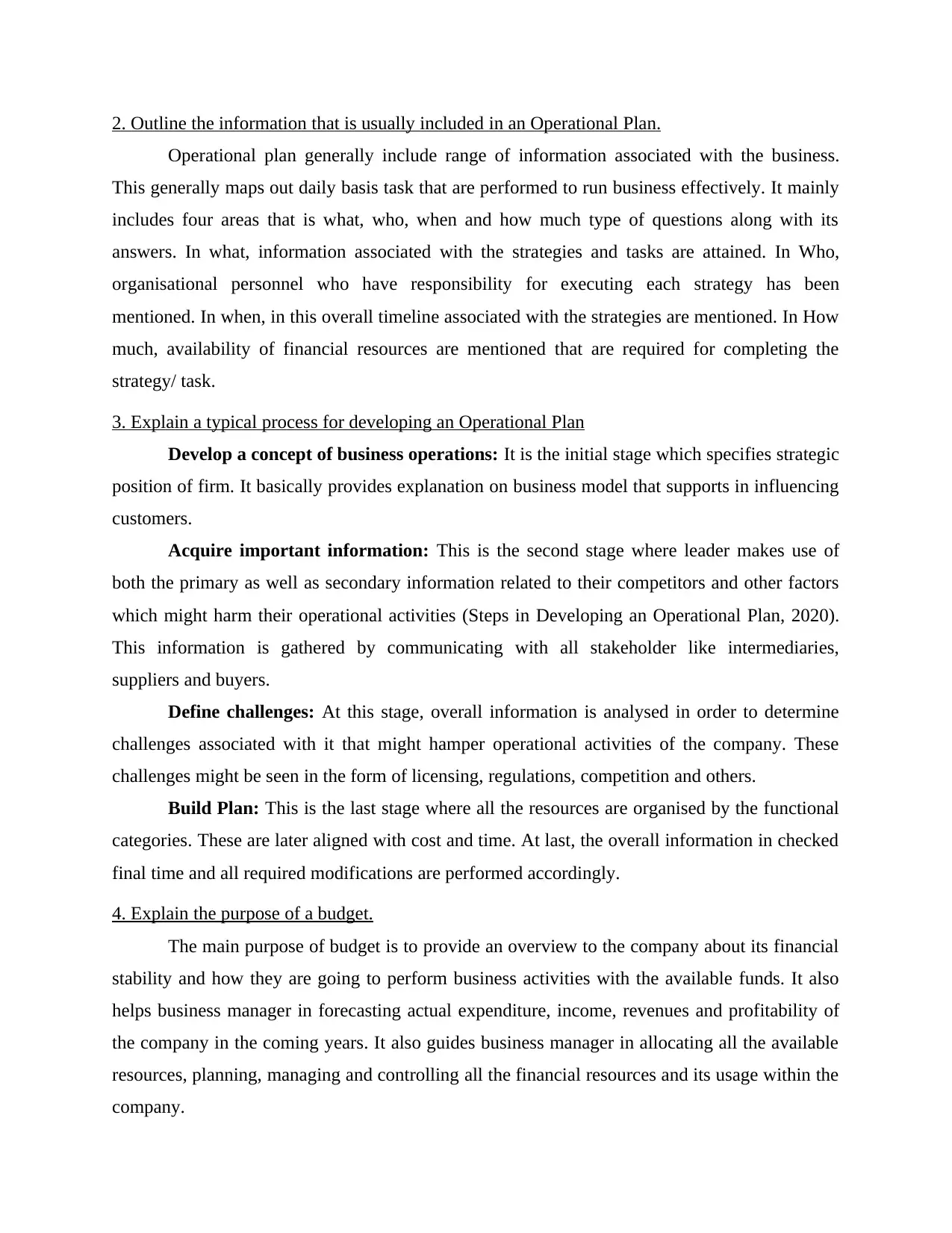
2. Outline the information that is usually included in an Operational Plan.
Operational plan generally include range of information associated with the business.
This generally maps out daily basis task that are performed to run business effectively. It mainly
includes four areas that is what, who, when and how much type of questions along with its
answers. In what, information associated with the strategies and tasks are attained. In Who,
organisational personnel who have responsibility for executing each strategy has been
mentioned. In when, in this overall timeline associated with the strategies are mentioned. In How
much, availability of financial resources are mentioned that are required for completing the
strategy/ task.
3. Explain a typical process for developing an Operational Plan
Develop a concept of business operations: It is the initial stage which specifies strategic
position of firm. It basically provides explanation on business model that supports in influencing
customers.
Acquire important information: This is the second stage where leader makes use of
both the primary as well as secondary information related to their competitors and other factors
which might harm their operational activities (Steps in Developing an Operational Plan, 2020).
This information is gathered by communicating with all stakeholder like intermediaries,
suppliers and buyers.
Define challenges: At this stage, overall information is analysed in order to determine
challenges associated with it that might hamper operational activities of the company. These
challenges might be seen in the form of licensing, regulations, competition and others.
Build Plan: This is the last stage where all the resources are organised by the functional
categories. These are later aligned with cost and time. At last, the overall information in checked
final time and all required modifications are performed accordingly.
4. Explain the purpose of a budget.
The main purpose of budget is to provide an overview to the company about its financial
stability and how they are going to perform business activities with the available funds. It also
helps business manager in forecasting actual expenditure, income, revenues and profitability of
the company in the coming years. It also guides business manager in allocating all the available
resources, planning, managing and controlling all the financial resources and its usage within the
company.
Operational plan generally include range of information associated with the business.
This generally maps out daily basis task that are performed to run business effectively. It mainly
includes four areas that is what, who, when and how much type of questions along with its
answers. In what, information associated with the strategies and tasks are attained. In Who,
organisational personnel who have responsibility for executing each strategy has been
mentioned. In when, in this overall timeline associated with the strategies are mentioned. In How
much, availability of financial resources are mentioned that are required for completing the
strategy/ task.
3. Explain a typical process for developing an Operational Plan
Develop a concept of business operations: It is the initial stage which specifies strategic
position of firm. It basically provides explanation on business model that supports in influencing
customers.
Acquire important information: This is the second stage where leader makes use of
both the primary as well as secondary information related to their competitors and other factors
which might harm their operational activities (Steps in Developing an Operational Plan, 2020).
This information is gathered by communicating with all stakeholder like intermediaries,
suppliers and buyers.
Define challenges: At this stage, overall information is analysed in order to determine
challenges associated with it that might hamper operational activities of the company. These
challenges might be seen in the form of licensing, regulations, competition and others.
Build Plan: This is the last stage where all the resources are organised by the functional
categories. These are later aligned with cost and time. At last, the overall information in checked
final time and all required modifications are performed accordingly.
4. Explain the purpose of a budget.
The main purpose of budget is to provide an overview to the company about its financial
stability and how they are going to perform business activities with the available funds. It also
helps business manager in forecasting actual expenditure, income, revenues and profitability of
the company in the coming years. It also guides business manager in allocating all the available
resources, planning, managing and controlling all the financial resources and its usage within the
company.
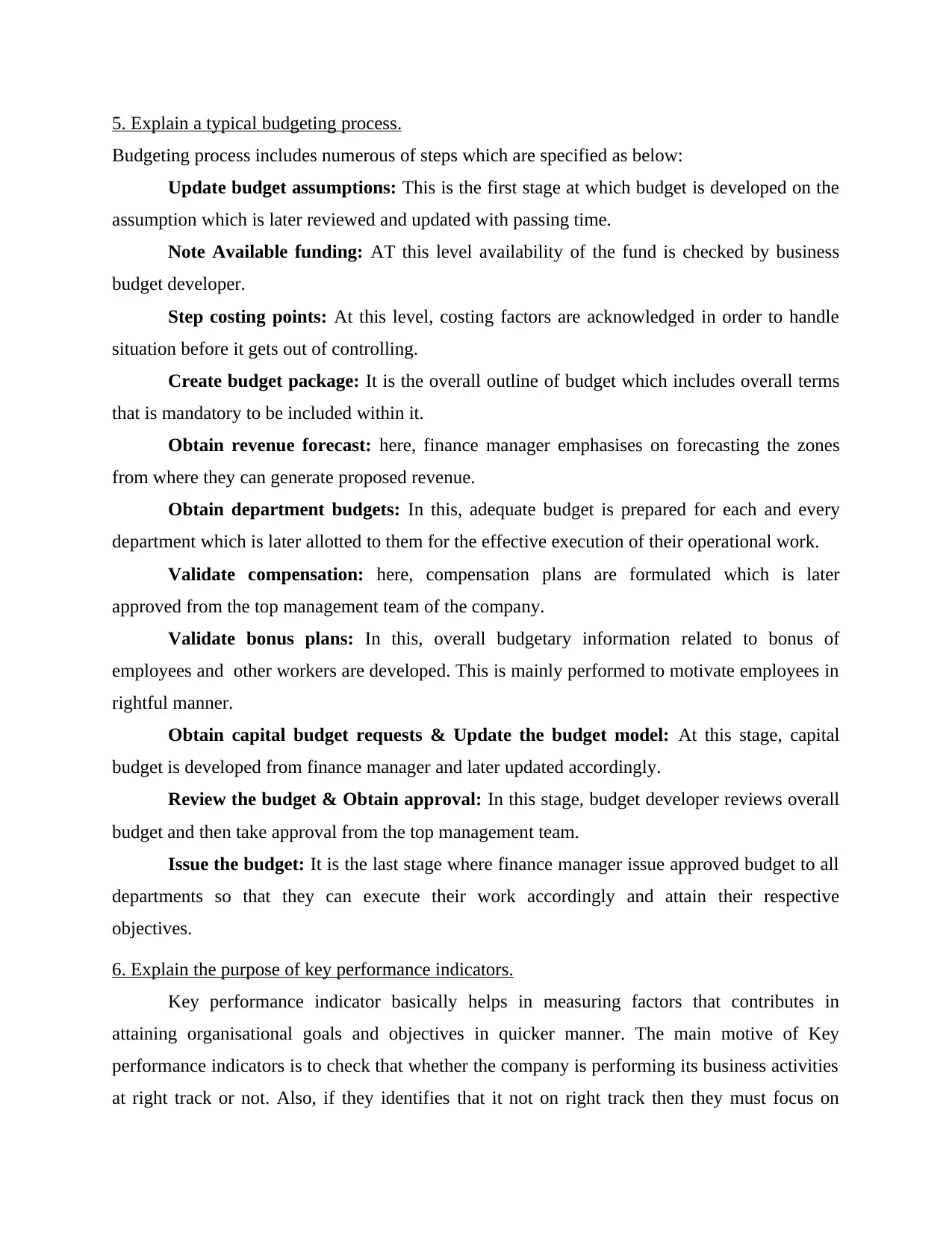
5. Explain a typical budgeting process.
Budgeting process includes numerous of steps which are specified as below:
Update budget assumptions: This is the first stage at which budget is developed on the
assumption which is later reviewed and updated with passing time.
Note Available funding: AT this level availability of the fund is checked by business
budget developer.
Step costing points: At this level, costing factors are acknowledged in order to handle
situation before it gets out of controlling.
Create budget package: It is the overall outline of budget which includes overall terms
that is mandatory to be included within it.
Obtain revenue forecast: here, finance manager emphasises on forecasting the zones
from where they can generate proposed revenue.
Obtain department budgets: In this, adequate budget is prepared for each and every
department which is later allotted to them for the effective execution of their operational work.
Validate compensation: here, compensation plans are formulated which is later
approved from the top management team of the company.
Validate bonus plans: In this, overall budgetary information related to bonus of
employees and other workers are developed. This is mainly performed to motivate employees in
rightful manner.
Obtain capital budget requests & Update the budget model: At this stage, capital
budget is developed from finance manager and later updated accordingly.
Review the budget & Obtain approval: In this stage, budget developer reviews overall
budget and then take approval from the top management team.
Issue the budget: It is the last stage where finance manager issue approved budget to all
departments so that they can execute their work accordingly and attain their respective
objectives.
6. Explain the purpose of key performance indicators.
Key performance indicator basically helps in measuring factors that contributes in
attaining organisational goals and objectives in quicker manner. The main motive of Key
performance indicators is to check that whether the company is performing its business activities
at right track or not. Also, if they identifies that it not on right track then they must focus on
Budgeting process includes numerous of steps which are specified as below:
Update budget assumptions: This is the first stage at which budget is developed on the
assumption which is later reviewed and updated with passing time.
Note Available funding: AT this level availability of the fund is checked by business
budget developer.
Step costing points: At this level, costing factors are acknowledged in order to handle
situation before it gets out of controlling.
Create budget package: It is the overall outline of budget which includes overall terms
that is mandatory to be included within it.
Obtain revenue forecast: here, finance manager emphasises on forecasting the zones
from where they can generate proposed revenue.
Obtain department budgets: In this, adequate budget is prepared for each and every
department which is later allotted to them for the effective execution of their operational work.
Validate compensation: here, compensation plans are formulated which is later
approved from the top management team of the company.
Validate bonus plans: In this, overall budgetary information related to bonus of
employees and other workers are developed. This is mainly performed to motivate employees in
rightful manner.
Obtain capital budget requests & Update the budget model: At this stage, capital
budget is developed from finance manager and later updated accordingly.
Review the budget & Obtain approval: In this stage, budget developer reviews overall
budget and then take approval from the top management team.
Issue the budget: It is the last stage where finance manager issue approved budget to all
departments so that they can execute their work accordingly and attain their respective
objectives.
6. Explain the purpose of key performance indicators.
Key performance indicator basically helps in measuring factors that contributes in
attaining organisational goals and objectives in quicker manner. The main motive of Key
performance indicators is to check that whether the company is performing its business activities
at right track or not. Also, if they identifies that it not on right track then they must focus on
⊘ This is a preview!⊘
Do you want full access?
Subscribe today to unlock all pages.

Trusted by 1+ million students worldwide
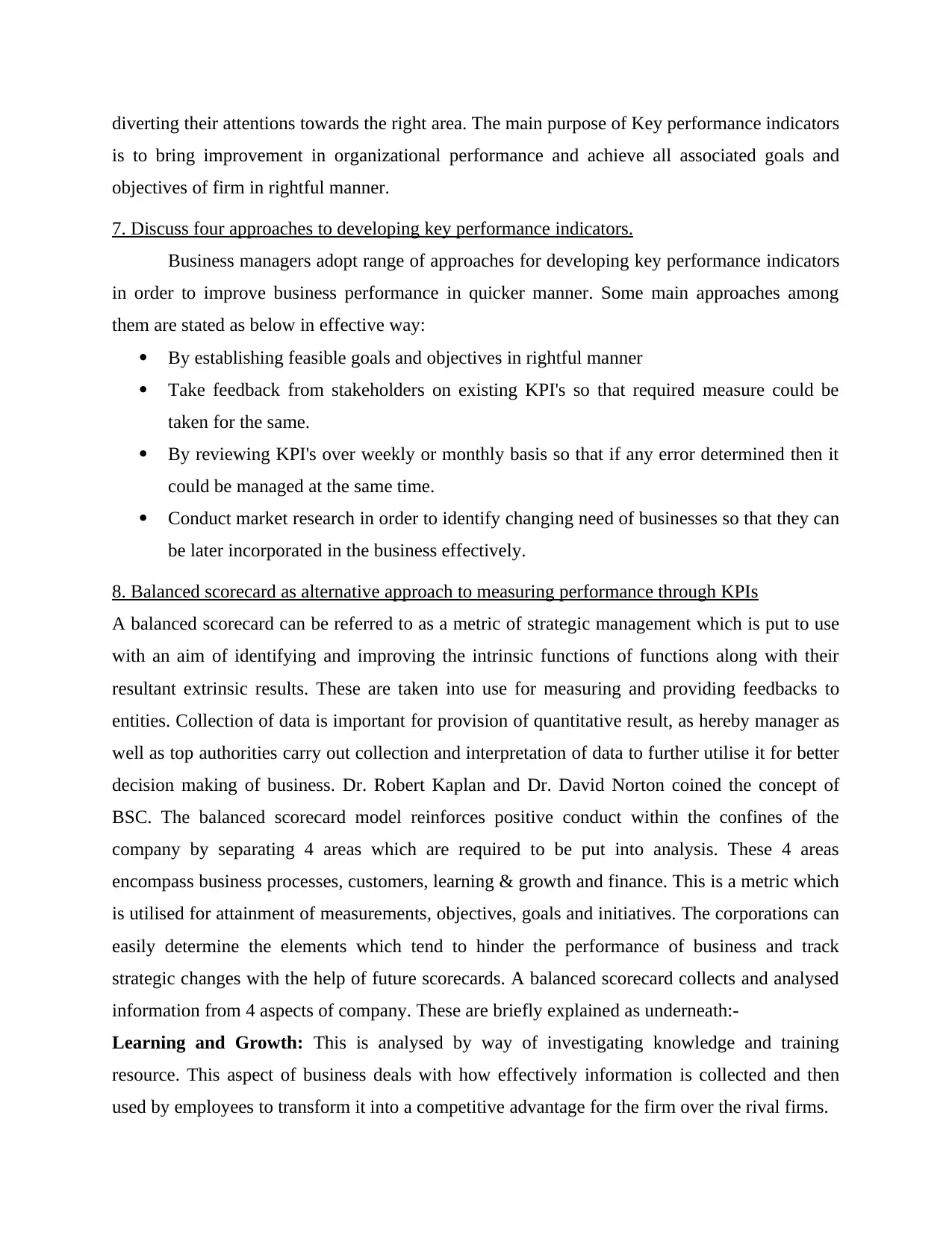
diverting their attentions towards the right area. The main purpose of Key performance indicators
is to bring improvement in organizational performance and achieve all associated goals and
objectives of firm in rightful manner.
7. Discuss four approaches to developing key performance indicators.
Business managers adopt range of approaches for developing key performance indicators
in order to improve business performance in quicker manner. Some main approaches among
them are stated as below in effective way:
By establishing feasible goals and objectives in rightful manner
Take feedback from stakeholders on existing KPI's so that required measure could be
taken for the same.
By reviewing KPI's over weekly or monthly basis so that if any error determined then it
could be managed at the same time.
Conduct market research in order to identify changing need of businesses so that they can
be later incorporated in the business effectively.
8. Balanced scorecard as alternative approach to measuring performance through KPIs
A balanced scorecard can be referred to as a metric of strategic management which is put to use
with an aim of identifying and improving the intrinsic functions of functions along with their
resultant extrinsic results. These are taken into use for measuring and providing feedbacks to
entities. Collection of data is important for provision of quantitative result, as hereby manager as
well as top authorities carry out collection and interpretation of data to further utilise it for better
decision making of business. Dr. Robert Kaplan and Dr. David Norton coined the concept of
BSC. The balanced scorecard model reinforces positive conduct within the confines of the
company by separating 4 areas which are required to be put into analysis. These 4 areas
encompass business processes, customers, learning & growth and finance. This is a metric which
is utilised for attainment of measurements, objectives, goals and initiatives. The corporations can
easily determine the elements which tend to hinder the performance of business and track
strategic changes with the help of future scorecards. A balanced scorecard collects and analysed
information from 4 aspects of company. These are briefly explained as underneath:-
Learning and Growth: This is analysed by way of investigating knowledge and training
resource. This aspect of business deals with how effectively information is collected and then
used by employees to transform it into a competitive advantage for the firm over the rival firms.
is to bring improvement in organizational performance and achieve all associated goals and
objectives of firm in rightful manner.
7. Discuss four approaches to developing key performance indicators.
Business managers adopt range of approaches for developing key performance indicators
in order to improve business performance in quicker manner. Some main approaches among
them are stated as below in effective way:
By establishing feasible goals and objectives in rightful manner
Take feedback from stakeholders on existing KPI's so that required measure could be
taken for the same.
By reviewing KPI's over weekly or monthly basis so that if any error determined then it
could be managed at the same time.
Conduct market research in order to identify changing need of businesses so that they can
be later incorporated in the business effectively.
8. Balanced scorecard as alternative approach to measuring performance through KPIs
A balanced scorecard can be referred to as a metric of strategic management which is put to use
with an aim of identifying and improving the intrinsic functions of functions along with their
resultant extrinsic results. These are taken into use for measuring and providing feedbacks to
entities. Collection of data is important for provision of quantitative result, as hereby manager as
well as top authorities carry out collection and interpretation of data to further utilise it for better
decision making of business. Dr. Robert Kaplan and Dr. David Norton coined the concept of
BSC. The balanced scorecard model reinforces positive conduct within the confines of the
company by separating 4 areas which are required to be put into analysis. These 4 areas
encompass business processes, customers, learning & growth and finance. This is a metric which
is utilised for attainment of measurements, objectives, goals and initiatives. The corporations can
easily determine the elements which tend to hinder the performance of business and track
strategic changes with the help of future scorecards. A balanced scorecard collects and analysed
information from 4 aspects of company. These are briefly explained as underneath:-
Learning and Growth: This is analysed by way of investigating knowledge and training
resource. This aspect of business deals with how effectively information is collected and then
used by employees to transform it into a competitive advantage for the firm over the rival firms.
Paraphrase This Document
Need a fresh take? Get an instant paraphrase of this document with our AI Paraphraser
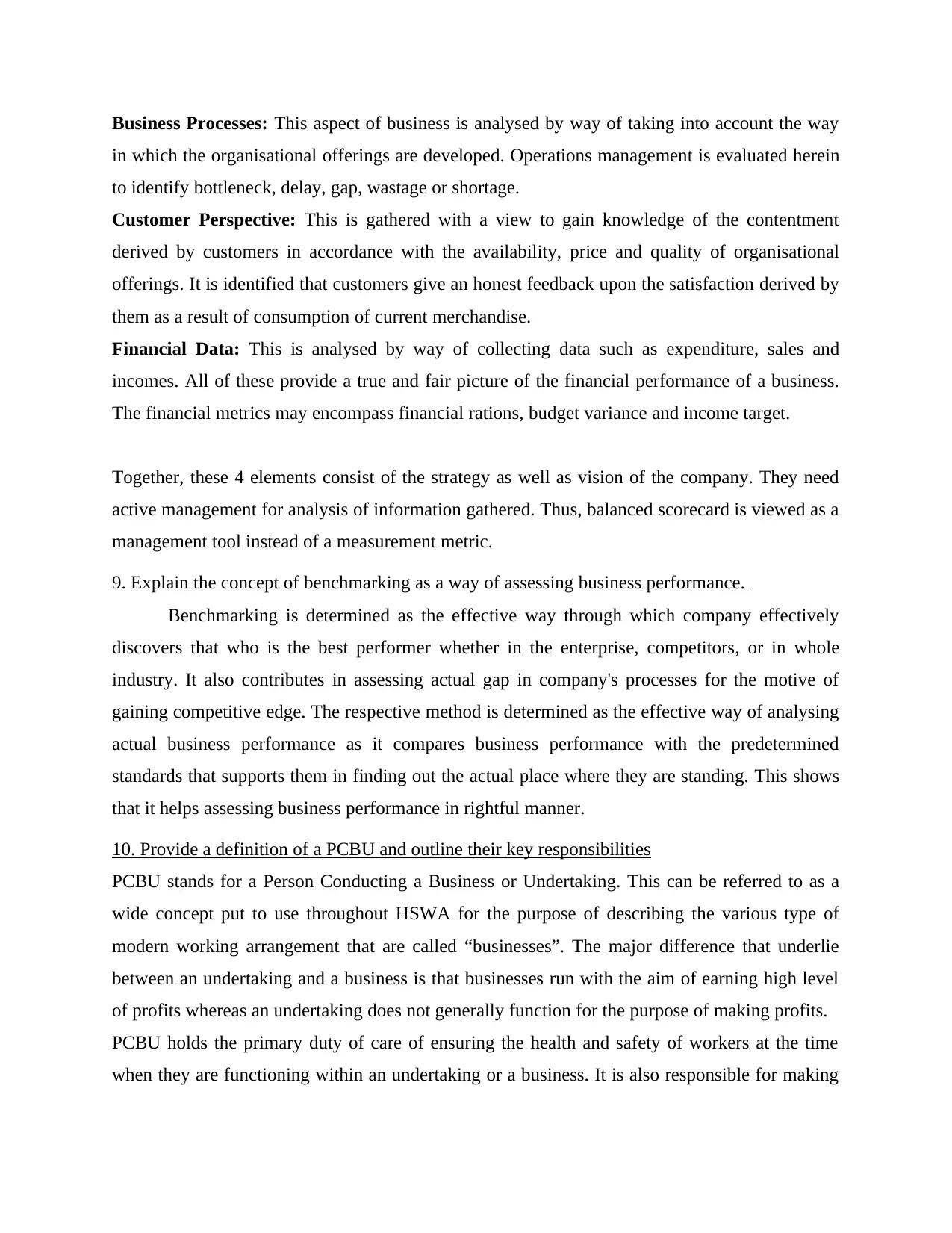
Business Processes: This aspect of business is analysed by way of taking into account the way
in which the organisational offerings are developed. Operations management is evaluated herein
to identify bottleneck, delay, gap, wastage or shortage.
Customer Perspective: This is gathered with a view to gain knowledge of the contentment
derived by customers in accordance with the availability, price and quality of organisational
offerings. It is identified that customers give an honest feedback upon the satisfaction derived by
them as a result of consumption of current merchandise.
Financial Data: This is analysed by way of collecting data such as expenditure, sales and
incomes. All of these provide a true and fair picture of the financial performance of a business.
The financial metrics may encompass financial rations, budget variance and income target.
Together, these 4 elements consist of the strategy as well as vision of the company. They need
active management for analysis of information gathered. Thus, balanced scorecard is viewed as a
management tool instead of a measurement metric.
9. Explain the concept of benchmarking as a way of assessing business performance.
Benchmarking is determined as the effective way through which company effectively
discovers that who is the best performer whether in the enterprise, competitors, or in whole
industry. It also contributes in assessing actual gap in company's processes for the motive of
gaining competitive edge. The respective method is determined as the effective way of analysing
actual business performance as it compares business performance with the predetermined
standards that supports them in finding out the actual place where they are standing. This shows
that it helps assessing business performance in rightful manner.
10. Provide a definition of a PCBU and outline their key responsibilities
PCBU stands for a Person Conducting a Business or Undertaking. This can be referred to as a
wide concept put to use throughout HSWA for the purpose of describing the various type of
modern working arrangement that are called “businesses”. The major difference that underlie
between an undertaking and a business is that businesses run with the aim of earning high level
of profits whereas an undertaking does not generally function for the purpose of making profits.
PCBU holds the primary duty of care of ensuring the health and safety of workers at the time
when they are functioning within an undertaking or a business. It is also responsible for making
in which the organisational offerings are developed. Operations management is evaluated herein
to identify bottleneck, delay, gap, wastage or shortage.
Customer Perspective: This is gathered with a view to gain knowledge of the contentment
derived by customers in accordance with the availability, price and quality of organisational
offerings. It is identified that customers give an honest feedback upon the satisfaction derived by
them as a result of consumption of current merchandise.
Financial Data: This is analysed by way of collecting data such as expenditure, sales and
incomes. All of these provide a true and fair picture of the financial performance of a business.
The financial metrics may encompass financial rations, budget variance and income target.
Together, these 4 elements consist of the strategy as well as vision of the company. They need
active management for analysis of information gathered. Thus, balanced scorecard is viewed as a
management tool instead of a measurement metric.
9. Explain the concept of benchmarking as a way of assessing business performance.
Benchmarking is determined as the effective way through which company effectively
discovers that who is the best performer whether in the enterprise, competitors, or in whole
industry. It also contributes in assessing actual gap in company's processes for the motive of
gaining competitive edge. The respective method is determined as the effective way of analysing
actual business performance as it compares business performance with the predetermined
standards that supports them in finding out the actual place where they are standing. This shows
that it helps assessing business performance in rightful manner.
10. Provide a definition of a PCBU and outline their key responsibilities
PCBU stands for a Person Conducting a Business or Undertaking. This can be referred to as a
wide concept put to use throughout HSWA for the purpose of describing the various type of
modern working arrangement that are called “businesses”. The major difference that underlie
between an undertaking and a business is that businesses run with the aim of earning high level
of profits whereas an undertaking does not generally function for the purpose of making profits.
PCBU holds the primary duty of care of ensuring the health and safety of workers at the time
when they are functioning within an undertaking or a business. It is also responsible for making
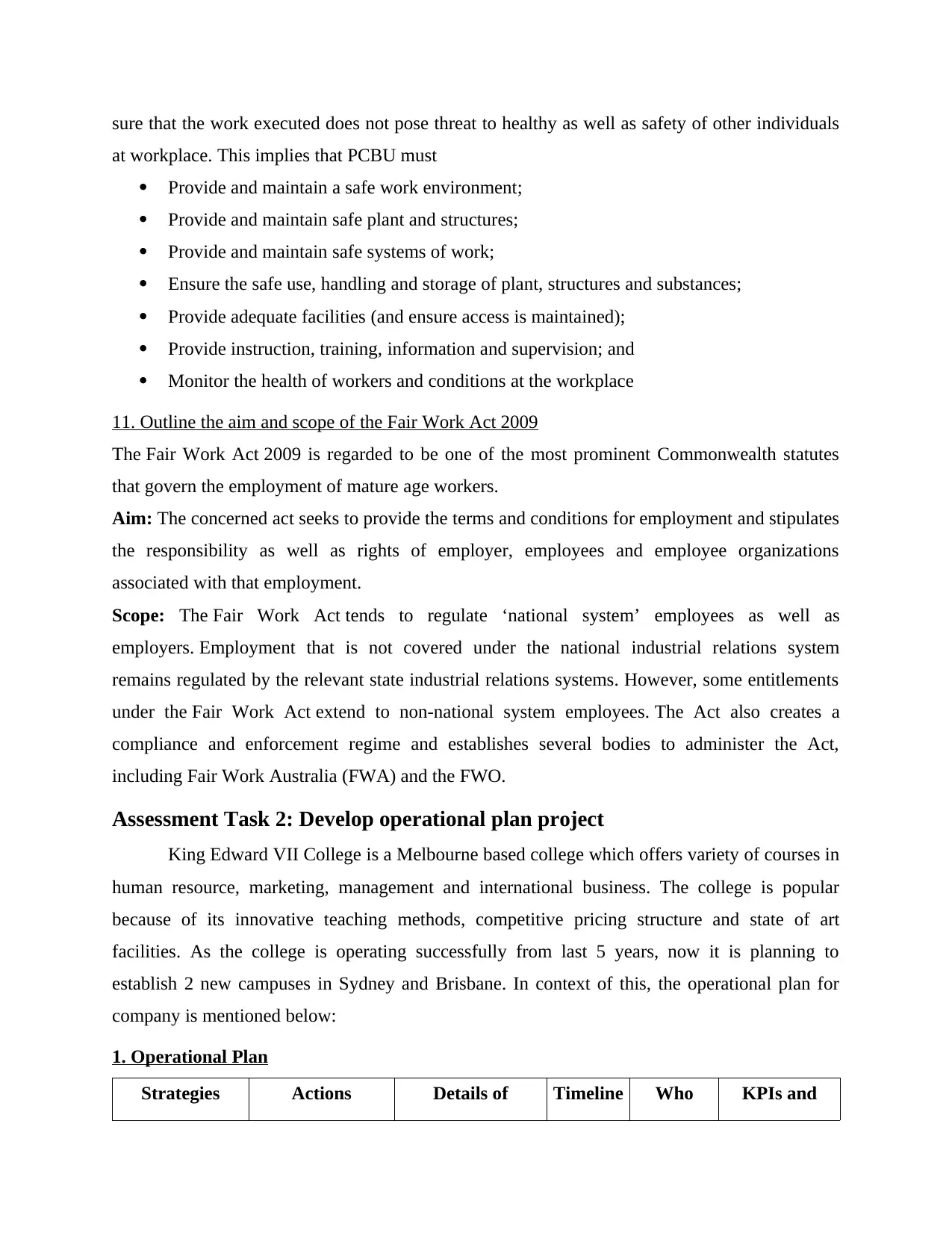
sure that the work executed does not pose threat to healthy as well as safety of other individuals
at workplace. This implies that PCBU must
Provide and maintain a safe work environment;
Provide and maintain safe plant and structures;
Provide and maintain safe systems of work;
Ensure the safe use, handling and storage of plant, structures and substances;
Provide adequate facilities (and ensure access is maintained);
Provide instruction, training, information and supervision; and
Monitor the health of workers and conditions at the workplace
11. Outline the aim and scope of the Fair Work Act 2009
The Fair Work Act 2009 is regarded to be one of the most prominent Commonwealth statutes
that govern the employment of mature age workers.
Aim: The concerned act seeks to provide the terms and conditions for employment and stipulates
the responsibility as well as rights of employer, employees and employee organizations
associated with that employment.
Scope: The Fair Work Act tends to regulate ‘national system’ employees as well as
employers. Employment that is not covered under the national industrial relations system
remains regulated by the relevant state industrial relations systems. However, some entitlements
under the Fair Work Act extend to non-national system employees. The Act also creates a
compliance and enforcement regime and establishes several bodies to administer the Act,
including Fair Work Australia (FWA) and the FWO.
Assessment Task 2: Develop operational plan project
King Edward VII College is a Melbourne based college which offers variety of courses in
human resource, marketing, management and international business. The college is popular
because of its innovative teaching methods, competitive pricing structure and state of art
facilities. As the college is operating successfully from last 5 years, now it is planning to
establish 2 new campuses in Sydney and Brisbane. In context of this, the operational plan for
company is mentioned below:
1. Operational Plan
Strategies Actions Details of Timeline Who KPIs and
at workplace. This implies that PCBU must
Provide and maintain a safe work environment;
Provide and maintain safe plant and structures;
Provide and maintain safe systems of work;
Ensure the safe use, handling and storage of plant, structures and substances;
Provide adequate facilities (and ensure access is maintained);
Provide instruction, training, information and supervision; and
Monitor the health of workers and conditions at the workplace
11. Outline the aim and scope of the Fair Work Act 2009
The Fair Work Act 2009 is regarded to be one of the most prominent Commonwealth statutes
that govern the employment of mature age workers.
Aim: The concerned act seeks to provide the terms and conditions for employment and stipulates
the responsibility as well as rights of employer, employees and employee organizations
associated with that employment.
Scope: The Fair Work Act tends to regulate ‘national system’ employees as well as
employers. Employment that is not covered under the national industrial relations system
remains regulated by the relevant state industrial relations systems. However, some entitlements
under the Fair Work Act extend to non-national system employees. The Act also creates a
compliance and enforcement regime and establishes several bodies to administer the Act,
including Fair Work Australia (FWA) and the FWO.
Assessment Task 2: Develop operational plan project
King Edward VII College is a Melbourne based college which offers variety of courses in
human resource, marketing, management and international business. The college is popular
because of its innovative teaching methods, competitive pricing structure and state of art
facilities. As the college is operating successfully from last 5 years, now it is planning to
establish 2 new campuses in Sydney and Brisbane. In context of this, the operational plan for
company is mentioned below:
1. Operational Plan
Strategies Actions Details of Timeline Who KPIs and
⊘ This is a preview!⊘
Do you want full access?
Subscribe today to unlock all pages.

Trusted by 1+ million students worldwide
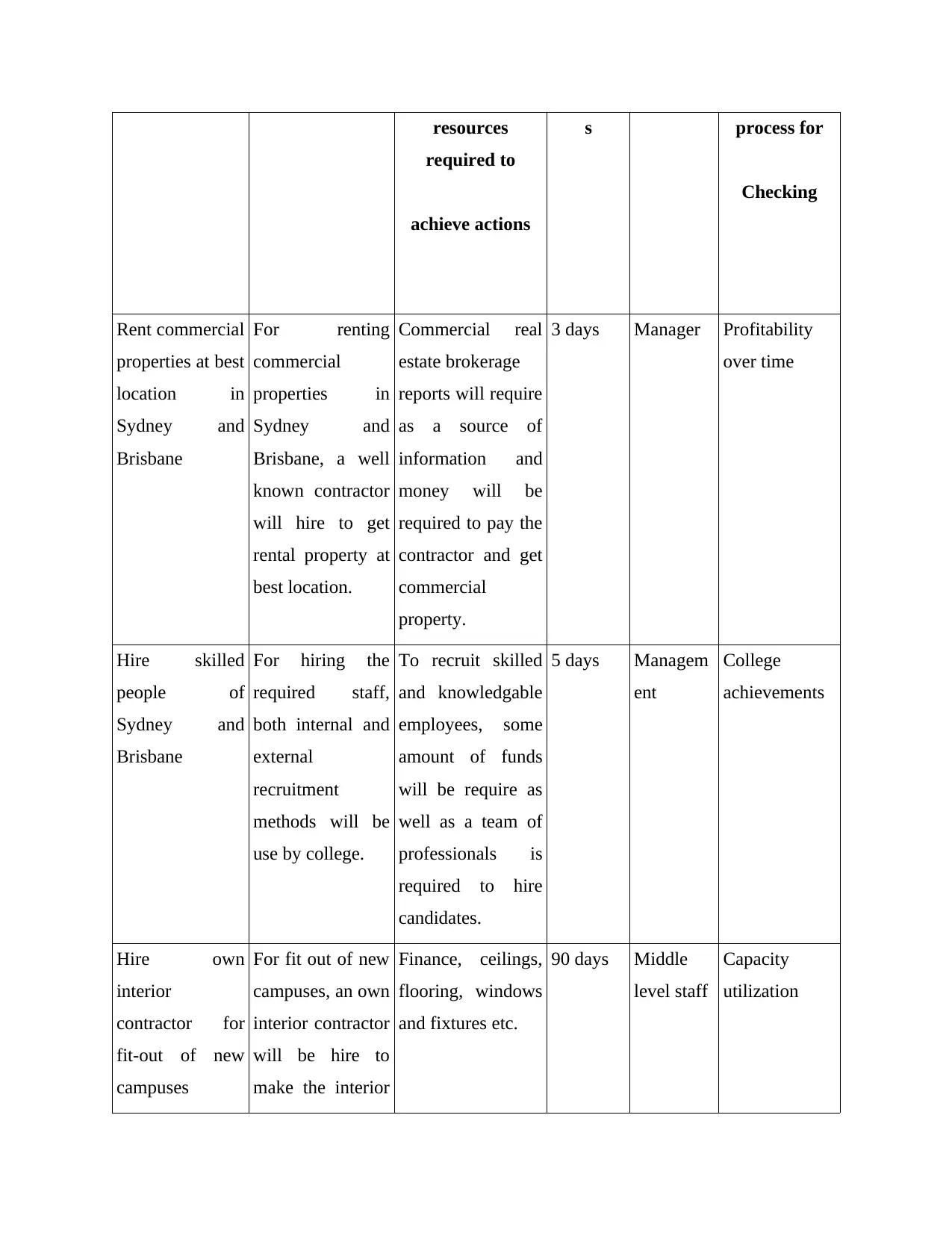
resources
required to
achieve actions
s process for
Checking
Rent commercial
properties at best
location in
Sydney and
Brisbane
For renting
commercial
properties in
Sydney and
Brisbane, a well
known contractor
will hire to get
rental property at
best location.
Commercial real
estate brokerage
reports will require
as a source of
information and
money will be
required to pay the
contractor and get
commercial
property.
3 days Manager Profitability
over time
Hire skilled
people of
Sydney and
Brisbane
For hiring the
required staff,
both internal and
external
recruitment
methods will be
use by college.
To recruit skilled
and knowledgable
employees, some
amount of funds
will be require as
well as a team of
professionals is
required to hire
candidates.
5 days Managem
ent
College
achievements
Hire own
interior
contractor for
fit-out of new
campuses
For fit out of new
campuses, an own
interior contractor
will be hire to
make the interior
Finance, ceilings,
flooring, windows
and fixtures etc.
90 days Middle
level staff
Capacity
utilization
required to
achieve actions
s process for
Checking
Rent commercial
properties at best
location in
Sydney and
Brisbane
For renting
commercial
properties in
Sydney and
Brisbane, a well
known contractor
will hire to get
rental property at
best location.
Commercial real
estate brokerage
reports will require
as a source of
information and
money will be
required to pay the
contractor and get
commercial
property.
3 days Manager Profitability
over time
Hire skilled
people of
Sydney and
Brisbane
For hiring the
required staff,
both internal and
external
recruitment
methods will be
use by college.
To recruit skilled
and knowledgable
employees, some
amount of funds
will be require as
well as a team of
professionals is
required to hire
candidates.
5 days Managem
ent
College
achievements
Hire own
interior
contractor for
fit-out of new
campuses
For fit out of new
campuses, an own
interior contractor
will be hire to
make the interior
Finance, ceilings,
flooring, windows
and fixtures etc.
90 days Middle
level staff
Capacity
utilization
Paraphrase This Document
Need a fresh take? Get an instant paraphrase of this document with our AI Paraphraser
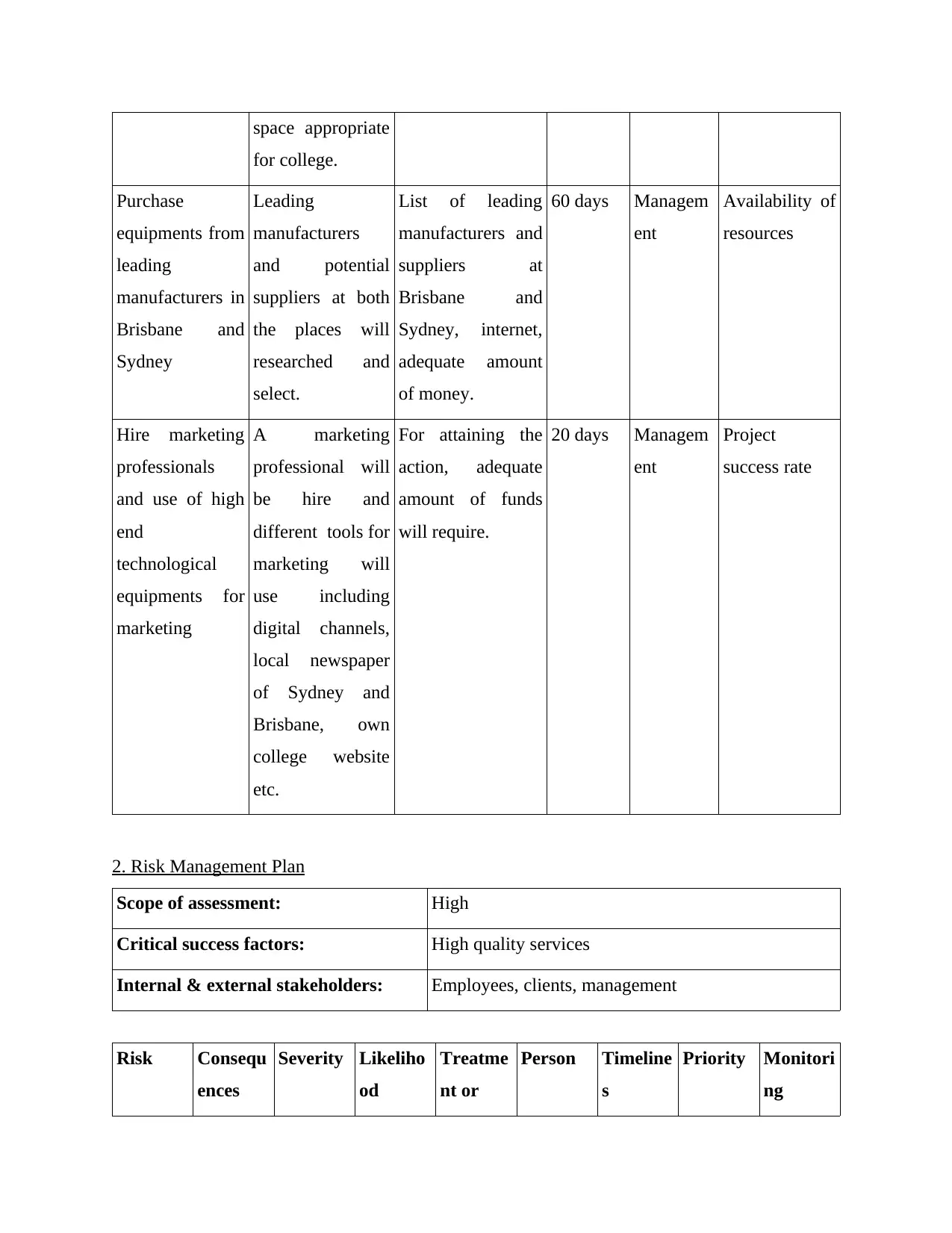
space appropriate
for college.
Purchase
equipments from
leading
manufacturers in
Brisbane and
Sydney
Leading
manufacturers
and potential
suppliers at both
the places will
researched and
select.
List of leading
manufacturers and
suppliers at
Brisbane and
Sydney, internet,
adequate amount
of money.
60 days Managem
ent
Availability of
resources
Hire marketing
professionals
and use of high
end
technological
equipments for
marketing
A marketing
professional will
be hire and
different tools for
marketing will
use including
digital channels,
local newspaper
of Sydney and
Brisbane, own
college website
etc.
For attaining the
action, adequate
amount of funds
will require.
20 days Managem
ent
Project
success rate
2. Risk Management Plan
Scope of assessment: High
Critical success factors: High quality services
Internal & external stakeholders: Employees, clients, management
Risk Consequ
ences
Severity Likeliho
od
Treatme
nt or
Person Timeline
s
Priority Monitori
ng
for college.
Purchase
equipments from
leading
manufacturers in
Brisbane and
Sydney
Leading
manufacturers
and potential
suppliers at both
the places will
researched and
select.
List of leading
manufacturers and
suppliers at
Brisbane and
Sydney, internet,
adequate amount
of money.
60 days Managem
ent
Availability of
resources
Hire marketing
professionals
and use of high
end
technological
equipments for
marketing
A marketing
professional will
be hire and
different tools for
marketing will
use including
digital channels,
local newspaper
of Sydney and
Brisbane, own
college website
etc.
For attaining the
action, adequate
amount of funds
will require.
20 days Managem
ent
Project
success rate
2. Risk Management Plan
Scope of assessment: High
Critical success factors: High quality services
Internal & external stakeholders: Employees, clients, management
Risk Consequ
ences
Severity Likeliho
od
Treatme
nt or
Person Timeline
s
Priority Monitori
ng
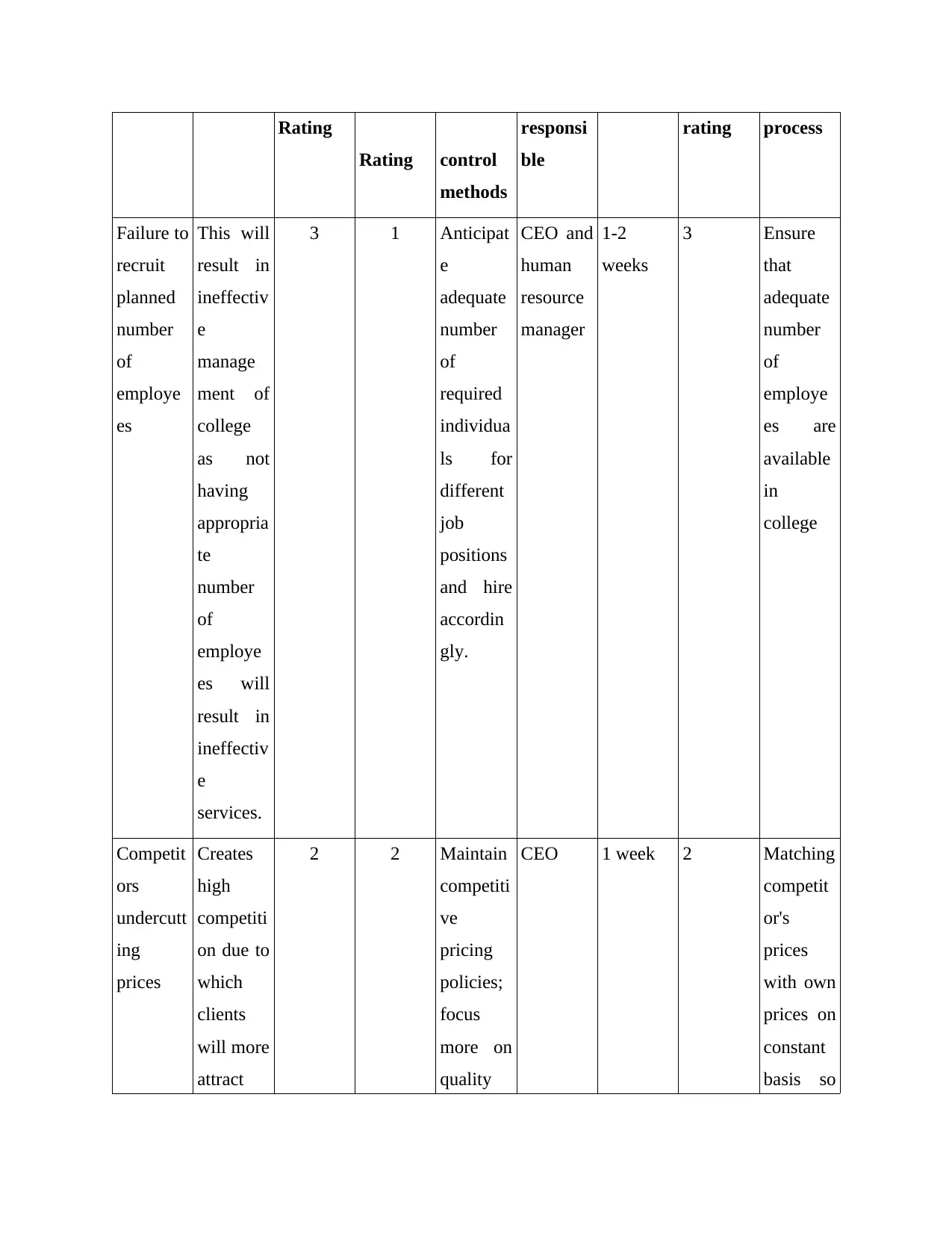
Rating
Rating control
methods
responsi
ble
rating process
Failure to
recruit
planned
number
of
employe
es
This will
result in
ineffectiv
e
manage
ment of
college
as not
having
appropria
te
number
of
employe
es will
result in
ineffectiv
e
services.
3 1 Anticipat
e
adequate
number
of
required
individua
ls for
different
job
positions
and hire
accordin
gly.
CEO and
human
resource
manager
1-2
weeks
3 Ensure
that
adequate
number
of
employe
es are
available
in
college
Competit
ors
undercutt
ing
prices
Creates
high
competiti
on due to
which
clients
will more
attract
2 2 Maintain
competiti
ve
pricing
policies;
focus
more on
quality
CEO 1 week 2 Matching
competit
or's
prices
with own
prices on
constant
basis so
Rating control
methods
responsi
ble
rating process
Failure to
recruit
planned
number
of
employe
es
This will
result in
ineffectiv
e
manage
ment of
college
as not
having
appropria
te
number
of
employe
es will
result in
ineffectiv
e
services.
3 1 Anticipat
e
adequate
number
of
required
individua
ls for
different
job
positions
and hire
accordin
gly.
CEO and
human
resource
manager
1-2
weeks
3 Ensure
that
adequate
number
of
employe
es are
available
in
college
Competit
ors
undercutt
ing
prices
Creates
high
competiti
on due to
which
clients
will more
attract
2 2 Maintain
competiti
ve
pricing
policies;
focus
more on
quality
CEO 1 week 2 Matching
competit
or's
prices
with own
prices on
constant
basis so
⊘ This is a preview!⊘
Do you want full access?
Subscribe today to unlock all pages.

Trusted by 1+ million students worldwide
1 out of 22
Related Documents
Your All-in-One AI-Powered Toolkit for Academic Success.
+13062052269
info@desklib.com
Available 24*7 on WhatsApp / Email
![[object Object]](/_next/static/media/star-bottom.7253800d.svg)
Unlock your academic potential
Copyright © 2020–2025 A2Z Services. All Rights Reserved. Developed and managed by ZUCOL.




